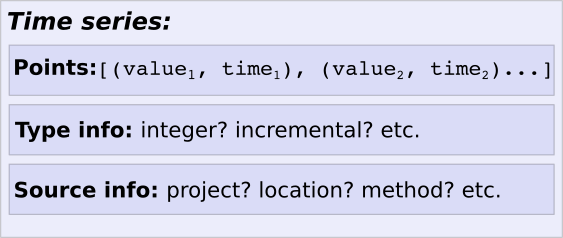本文件說明 Cloud Monitoring 如何模擬收集到的測量資料,這些資料可協助您瞭解應用程式和系統服務的效能。Cloud Monitoring 的監控資料模型由三個主要概念構成:受控資源類型、指標類型和時間序列:
受控資源類型是計量資料的來源,例如應用程式和系統服務。 可監控的資源類型超過 270 種。 如需最新清單,請參閱「受控資源清單」。
指標類型定義要評估的屬性,例如 CPU 使用率。 Monitoring 提供超過 6,500 種指標,可用於監控 Google Cloud、AWS 和各種第三方軟體。 如需指標類型清單,請參閱「指標清單」。 如果您需要未定義的內容,可以自行建立。
「時間序列」是指來自特定受控資源的一系列評估結果。
如需這些概念的簡介,以及它們之間的關聯,請參閱這份文件。下列文件提供更深入的資訊:
- 如要瞭解標籤和時間序列基數,以及受控資源和指標類型的範例,請參閱「指標模型的元件」。
- 如要進一步瞭解時間序列,包括 Cloud Monitoring API 如何呈現時間序列,請參閱「時間序列的結構」。如果您打算使用 Monitoring API 或自訂指標,這項資訊就特別實用。
Cloud Monitoring 指標模型
指標是指一組相關測量值,用於評估您監控的資源的某些屬性。測量項目可能包括對服務要求的延遲時間、機器可用的磁碟空間量、SQL 資料庫中的資料表數量、已售出的小工具數量等等。資源可能包括虛擬機器 (VM)、資料庫執行個體、磁碟等。
Cloud Monitoring 中指標的一般概念包含三個主要元件:
- 測量資料來源的相關資訊。
- 某個屬性的一組測量資料。每個測量值都會以帶有時間戳記的值記錄下來。
- 所測量資源的值相關資訊。
舉例來說,假設有一個指標可追蹤商店售出的 Widget 數量。模型的元件會以以下方式對應至此範例:
測量資料來源
指標模型會記錄每個受監控資源的相關資訊。擷取的特定資訊取決於所監控的資源類型:可能包括地理位置、方法名稱、磁碟 ID 等,也就是任何可能成為評估來源的資訊。

監控資料的來源稱為「受控資源」。
範例:在小工具銷售範例中,監控的資源是銷售小工具的商店。
成效評估
指標模型會將屬性測量值擷取為一組資料點,其中包含帶有時間戳記的值。

值通常為數值,但這取決於您要評估的項目。
範例:在小工具銷售量範例中,評估會記錄某個時間點的銷售資訊。這類測量結果可能會像這樣:
[(150, 2024-05-23T17:37:00-04:00), (229, 2024-05-23T17:38:00-04:00), (138, 2024-05-23T17:39:00-04:00), ...]
值的相關資訊
如果沒有解讀方式的相關資訊,測量值就毫無意義。您需要提供一些關於值的「類型」資訊,例如資料類型、單位和每個測量值的類型:
- 值是整數還是字串?
- 這個值代表每小時英里數還是弧度?
- 這個值代表當時的總數,還是與先前值的差異?

Cloud Monitoring 會呼叫您要評估的指標類型的每個特性組合。
範例:在小工具銷售範例中,這項資訊可能會告訴您以下資訊:
- 每個值都會記錄為 64 位元整數。
- 每個值都代表已售出的小工具數量。
- 每個值都代表自上次記錄的評估以來,所售出小工具的數量。
時間序列:將元件組合
在 Cloud Monitoring 中,這個模型的基礎資料結構是時間序列 (單數和複數形式相同)。
每個時間序列都包含模型的三個元件:
- 說明測量資料來源的受監控資源。
- 與單一受控資源相關聯的一系列測量資料。
- 指標類型的說明,說明您要評估的項目。

示例:在小工具銷售量範例中,時間序列包含下列項目:
- 說明這個時間序列中所計算的子商品所屬商店。
- 這個商店記錄的一系列評估指標。
- 值說明:64 位元整數,用於評估自上次記錄值以來售出的小工具數量。
單一 Cloud Monitoring 指標類型或受控資源類型可與多個相關時間序列建立關聯。在小工具銷售範例中,每個販售小工具的商店都會將資料儲存在時間序列中,因此如果有 15 間販售小工具的商店,就會有 15 個記錄小工具銷售情形的時間序列。
後續步驟
- 如要進一步瞭解 Cloud Monitoring 指標的結構,請參閱
- 如要瞭解匯總、分組和篩選等時序作業,請參閱「篩選和匯總:操控時序」。
- 如需術語相關說明,請參閱「術語注意事項」。

